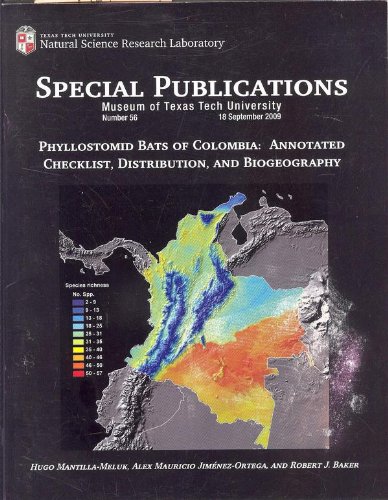

Most ebook files are in PDF format, so you can easily read them using various software such as Foxit Reader or directly on the Google Chrome browser.
Some ebook files are released by publishers in other formats such as .awz, .mobi, .epub, .fb2, etc. You may need to install specific software to read these formats on mobile/PC, such as Calibre.
Please read the tutorial at this link: https://ebookbell.com/faq
We offer FREE conversion to the popular formats you request; however, this may take some time. Therefore, right after payment, please email us, and we will try to provide the service as quickly as possible.
For some exceptional file formats or broken links (if any), please refrain from opening any disputes. Instead, email us first, and we will try to assist within a maximum of 6 hours.
EbookBell Team

5.0
58 reviews
ISBN 10: 1929330189
ISBN 13: 9781929330188
Author: Hugo Mantilla Meluk
We report 118 confirmed phyllostomid species for Colombia, and 14 species po¬ tentially present in the country, for a total of 132 species representing 40 genera and 10 subfamilies. All known phyllostomid subfamilies are represented in Colombia, with the exception of the subfamily Macrotinae (not present in South America). At 118 known species, Colombia has the greatest number of phyllostomid bats ofany country. Included in the lists are 27 recently recognized species (19 newly described species and eight newly elevated species), 19 ofwhich are confirmed for Colombia, while eight are potentially present. The checklist is accompanied by 18 taxonomic comments explain¬ ing recent changes in the taxonomy ofthe group. In addition. Geographic Information Systems (GlS)-based models ofpotential distribution were created for both confirmed and potentially present phyllostomid species, and species richness patterns were ana¬ lyzed. Finally, comments on the biogeography ofthe group are included.
1. Introduction
1.1. Purpose and Scope of the Study
1.2. Overview of the Family Phyllostomidae
1.3. Historical Studies on Colombian Phyllostomids
1.4. Importance of Colombia in Neotropical Chiropteran Diversity
1.5. Objectives
2. Materials and Methods
2.1. Study Area and Geographical Coverage
2.2. Data Sources (Museum Records, Field Collections, Literature)
2.3. Taxonomic Criteria and Nomenclature
2.4. Mapping and Distributional Analyses
2.5. Biogeographic and Ecological Classifications
3. Overview of Phyllostomid Diversity in Colombia
3.1. Species Richness and Endemism
3.2. Major Subfamilies and Tribes
3.3. Habitat Associations
3.4. Trophic Guilds and Ecological Roles
4. Annotated Checklist of Phyllostomid Bats in Colombia
(Main section – alphabetical or taxonomic order)
Each species entry typically includes:
Scientific Name and Author
Synonyms
Common Name(s)
Diagnostic Characters
Distribution in Colombia (with map)
Ecological Notes
Conservation Status
Remarks and References
Subfamilies and Genera
Subfamily Desmodontinae – Vampire bats (Desmodus, Diphylla, Diaemus)
Subfamily Glossophaginae – Nectar-feeding bats (Anoura, Glossophaga, etc.)
Subfamily Carolliinae – Fruit-eating bats (Carollia spp.)
Subfamily Stenodermatinae – Large frugivores (Artibeus, Platyrrhinus, Uroderma, etc.)
Subfamily Phyllostominae – Insectivores and carnivores (Phyllostomus, Micronycteris, Tonatia, etc.)
Other Minor Lineages (if applicable)
5. Distributional Patterns and Biogeography
5.1. Regional Patterns of Species Richness
5.2. Elevational Gradients and Habitat Zones
5.3. Endemism and Range Extensions
5.4. Biogeographic Provinces of Colombia
5.5. Comparison with Neighboring Countries
5.6. Implications for Conservation and Evolutionary History
6. Conservation Considerations
6.1. Threatened and Data-Deficient Species
6.2. Habitat Loss and Fragmentation
6.3. Role of Protected Areas
6.4. Recommendations for Future Research and Management
7. Conclusions
Summary of Findings
Key Biogeographic Insights
Future Directions for Colombian Ch
phyllostomid bats of colombia
phyllostomidae bats
bats of colombia
colombia bats
types of phyllostomidae
Tags: Hugo Mantilla Meluk, Phyllostomid, Bats